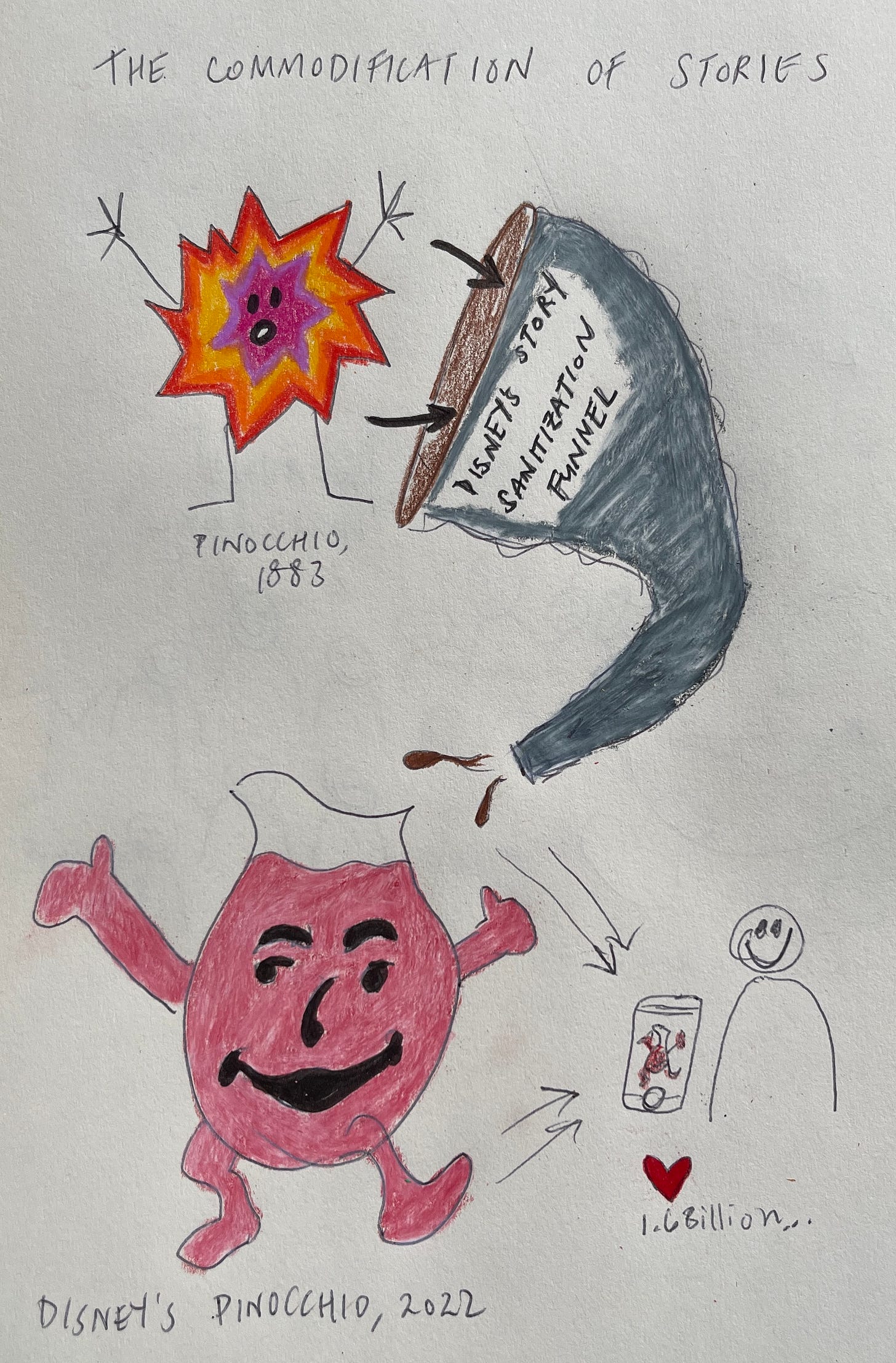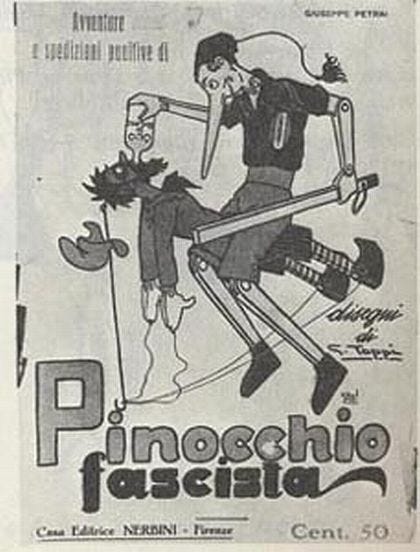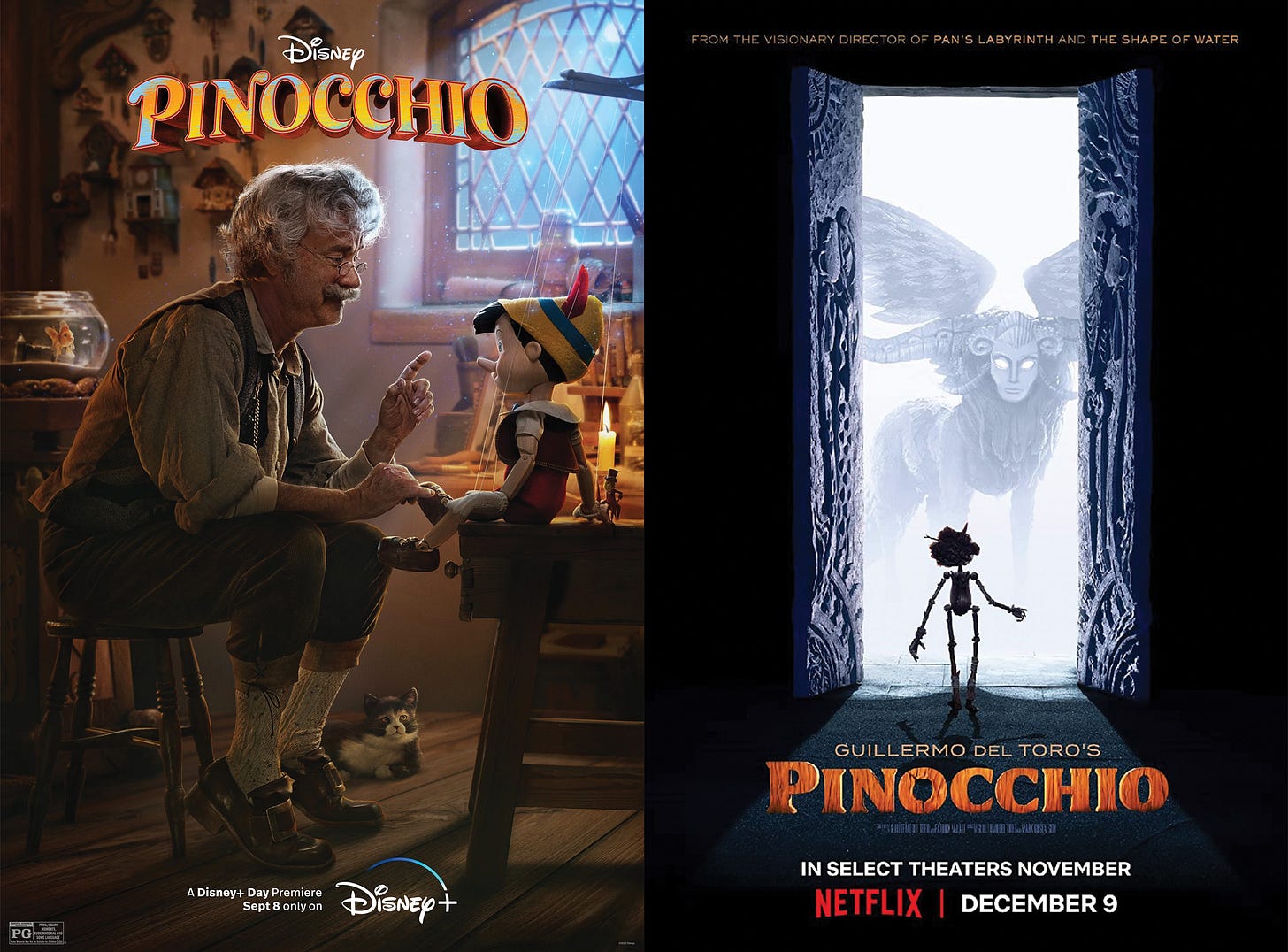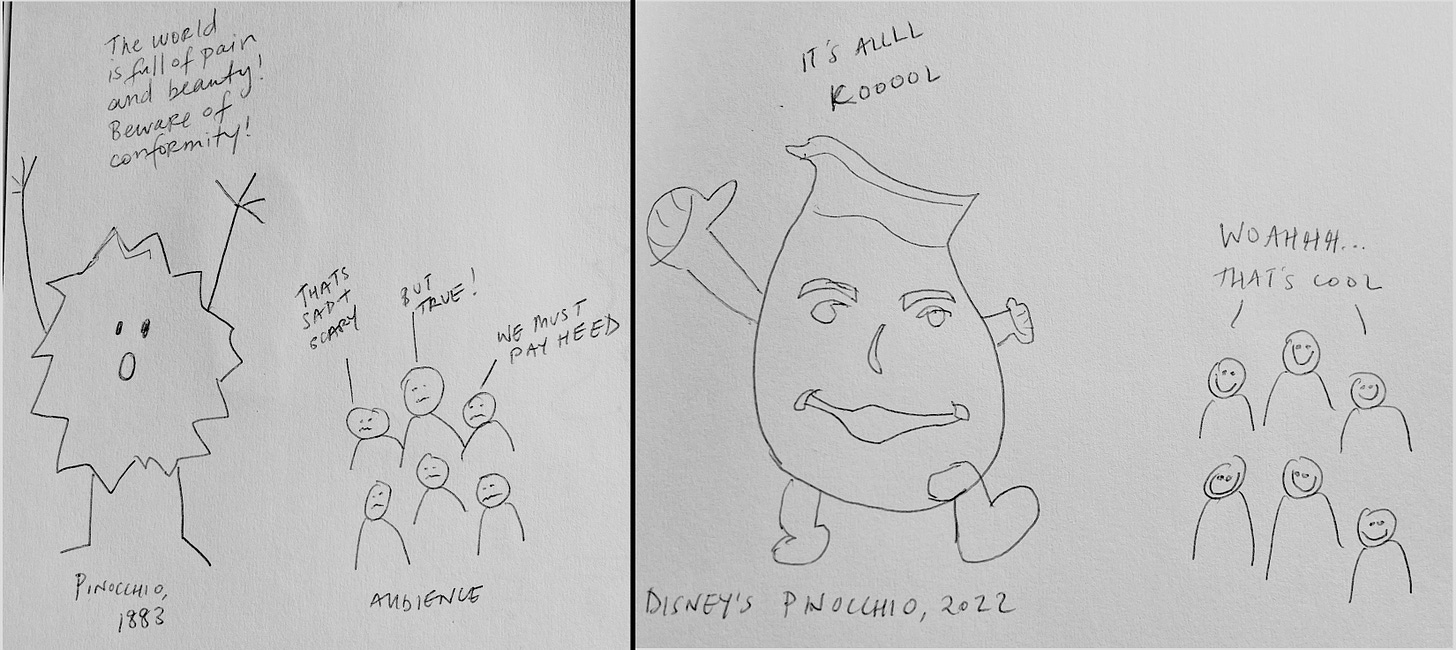In 2022, both Disney and Netflix released their own takes on the children’s classic: Pinocchio. Disney churned out a corporate live-action version of their animated classic, while Netflix released a much edgier take on the film, directed by Guillermo del Toro and more faithful to the original 1883 story. The release of two Pinocchios in one year allows the studios to capitalize on each other’s marketing, while also creating a distinct example of the commercialization of myths.
Del Toro’s dark fantastical version of a stop-motion Pinocchio has prompted negative reviews by family-viewers whose chief complaint is that the edgy take on the film is fodder for children’s nightmares. Yet the over-sanitization of content is leading to a psychic disconnect. This disconnect is between <the evolutionary purpose of stories> and <stories as entertainment>.
Literary Scholar Jonathan Gottschall has drawn upon neuroscience, psychology, and evolutionary biology to develop a theory on the storytelling. His argument is that “stories help us navigate life’s complex social problems—just as flight simulators prepare pilots for difficult situations. Storytelling has evolved, like other behaviors, to ensure our survival.”
“In the same way that plankton isn’t aware that it’s tumbling through salt water, we humans aren’t aware that we are constantly moving through story—from novels, to films, to religious myths, to dreams and fantasies, to jokes, pro wrestling, and children’s make believe,” Gottschall says in an interview with Scientific American.
Stories originated as an evolutionary function to forewarn, inspire wisdom, and share truths left otherwise to the realm of the esoteric. So what happens when we take a story that touches on primordial themes and transform it into the wind-up doll version of itself?
That is to say, what happens when we take the dark twisted fantasy of the original Pinocchio, with all of its tragedy and suffering, and transform it into a Disney-washed “clinically-happy” story? Although Disney’s squeaky-clean image comes paired with matching tiger moms who vouch for the company’s “family-friendly” content, psychologist and anthropologists have argued that there are “cathartic and developmental benefits” to depictions of aggression in children’s folk fairy tales. Therefore there is a case to be made that the sanitization of storytelling through the Disney flywheel actually inhibits children’s primary development.
The concern is this: Are audiences becoming increasingly numbed and therefore less tolerant to “watching” stories with difficult subjects?
If so, then media is losing the ability to expound Truth.
That is scary. That means that all the media sources that we rely on to get our factual information have a financial incentive to make content palatable in order to mask inconvenient truths.
Is it just me, or is toddler-favorite CoComelon super eerie? Most likely it falls somewhere in the uncanny valley. To wit – We are dumbing down characters to non-confrontational entertainment and easy social media ‘likes.’ This content disguises the lived experience of childhood into unreal, unidimensional characters with surface level plot. Carlo Collodi’s original tale about a non-conforming “real” boy has been made into a charming fantasy about wooden dolls and crickets.
The devolution of storytelling is something like this :

The original Pinocchio, by Carlo Collodi, written in 1883, portrayed scenes with the wooden marionette begging for money only to learn that it is better to do honest work for a penny than to be hungry and filled with pride. Over a century later, what keeps us as moviegoers returning to the ~Grimm~ stories of wooden boys and absent fathers? For Disney, this is largely a function of analysts combing through Disney’s IP library to identify which content could safely be rebooted for old viewers. Old viewers mean new parents who are ready to introduce their kids into the Disney machine. The live-action Tom Hanks rendition of Pinocchio that came out this past year is another Disney-ified iteration of a classic fable that has stripped the reality out of the story. Ironic given the film centers around the desire for Pinocchio to be a ‘real boy.’

Now let’s turn to Guillermo del Toro’s 2022 version of Pinocchio.
By contrast, del Toro’s Pinocchio uses the character’s politically rife history to set the stage for his film. Del Toro’s film is set in a fascist Italy (turning the historical use of Pinocchio in Italian pro-fascist propaganda on its head) about a boy who can say “no” - and therein, retain his autonomy and authentic non-conformity (disobedience as a virtue). In an interview with the Wall Street Journal, del Toro says, “Pinocchio is one of the primordial literary myths…You can make a Pinocchio that serves as a reading of family dynamics, or social dynamics, or as a story about truth and lies.” Federico Fellini, Francis Ford Coppola, Stanley Kubrick and Ron Howard all expressed interested in making Pinocchio movies. Del Toro said, "I made it clear [to Netflix, which financed the film] that I'm not making this for kids, I'm not making it for the soccer parents. I'm making this for myself and my team."
**🚨 SPOILER ALERT 🚨**
Guillermo del Toro’s Pinocchio starts by developing the backstory behind the character of Geppetto, Pinocchio’s creator. After watching the musical joy between Geppetto and his son Carlo, the audience quickly shares in Geppetto’s loss when Carlo is killed by a bombing raid on their village church. Geppetto’s subsequent alcohol abuse leads to a series of events and end in the creation of Pinocchio. The foremost expert in fantasy writing, del Toro carefully interplays the use of magic and spirituality with the world of the characters, deus ex machina. Rather than a flat narrative where a character’s personality and choices are arbitrarily in service to plot, del Toro takes an inside-out approach. Toro’s characters start in a world with joy, and we slowly observe how human injustice wears the characters down. Even minor characters, such as Candlewick and Spazzatura, make moral choices amidst cruelty. Unlike in other versions of the film, Del Toro’s version of Sebastian J. Cricket, the narrator, has a complete character arc. We meet him as a self absorbed novelist looking for a place to write and end his arc with him sacrificing his ambitions in order for Pinocchio to live.
What’s more, Pinocchio must learn about death. Perhaps the most profound moment we experience in the film is when Pinocchio chooses to make a deal with Death, agreeing to sacrifice his last life in order to save Geppetto. Pinocchio does not make it out alive. This moment is crucial in rendering the true authenticity of the film: Death is real.
**🚨 END SPOILERS 🚨**
Bringing us to the importance of a true death in fairytales.
The study by Elizabeth P. Lamers, M.A., titled “Children, Death, and Fairy Tales” explores the function of and differences between myth, fairytales, and folk tales as it relates to transmitting information about life to children.
Three relevant explanations regarding the function of fairy tales:
Rollo May:
“[Fairytales are] our myths before we become conscious of ourselves” [31, p. 1961].
Bruno Bettelheim:
“The figures and events of fairy tales . . . personify and illustrate inner conflicts, but they suggest ever so subtly how these conflicts may be solved, and what the next steps in the development toward a higher humanity might be . . . presented in a simple homely way . . . Far from making demands, the fairy tale reassures, gives hope for the future, and holds out the promise of a happy ending” [32, p. 261].
Madonna Kolbenschlag:
“Fairy tales are the bedtime stories of the collective consciousness. They persist in cultural memory because they interpret crises of the human condition that are common to all of us. They are shared wish fulfillments, abstract dreams that resolve conflicts and give meaning to experience” [33, p. 21].
It is widely accepted that fairy tales go beyond the function of children’s storytelling or entertainment, but penetrate into a Jungian collective consciousness and function as myths do. They teach us about how to be human.
According to Lamers, understanding death and dying as a natural process is a lifelong relationship a person has based on our experiences in childhood. “Adults are beginning to recognize the difficulties they have experienced as a result of being sheltered from an awareness of mortality…The need is felt for a way to transmit a realistic awareness of mortality to children,” she writes.
According to Lamer, a failed sense of mortality in childhood often carries into our perception of reality in adulthood.
What is insinuated in her work is that our modern adults, raised on idyllic fairytales with happy endings, have a failed sense of reality.
This failure in understanding what is real and what isn’t is exacerbated by the Metaverse, our digital presence, social media, and more.
So the double release of Pinocchio in 2022 showcases the difference between what real myth-building looks like versus what happens when our stories becomes commercialized and packaged for mass-consumption. The example of Pinocchio is really a case to be made about our content in general.
The saturation of media and bite-sized content is leading to a failure in our ability to process real and honest storytelling. The failure of real storytelling is leading to a broken reality in the minds of adults and young people. A failed sense of reality means anxiety, not-knowing who we are as a species, and loss of moral purpose.
Is this a fatalistic view of media? Perhaps. But I propose an experiment in analyzing your media consumption. If we keep track of all the content we watch in 1 week, including news articles, Instagram posts, YouTube videos, Linkedin feeds and so forth, and we run an analysis on our anxiety levels consuming different forms of content, I would be curious to see if there’s a correlation. Based on my qualitative perspective, there certainly is.
In conclusion, Guillermo del Toro is the GOAT in the genre of fantasy film. And it behooves us to have a stricter media diet. In sum, the commercial interests of studios rely on the consumption preferences of individuals.
Here is my media prescription for you.
Contemplate your relationship to Death.
Walk in nature and put your hand on a tree.
Sit in solitude in a silent patch of wilderness for 1 hour.
Once you’ve done the above, comment below and tell me what you’ve learned. This is the best way to undo our media brainwashing, doctor’s orders.
Thoughts on the subject? On the writing? All feedback is welcome. Drop a comment below, and let’s discuss further.






The steadfast Tin soldier-
It used to make me cry and I was never sure exactly why… i was 3-4 years old.
Something about the soldier standing on one leg and the ballerina also being on one leg and being in love deeply impacted me….
The way they both ended up in the fire and the only thing left was a heart… a metal heart with the ballerina’s spangle…..
Something about it still moves and upsets me